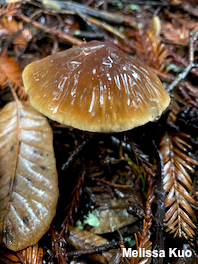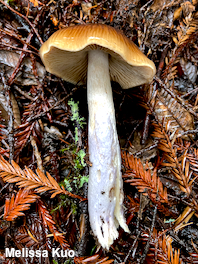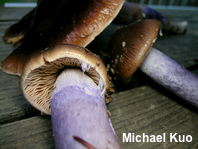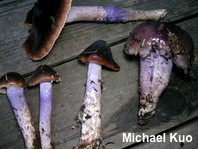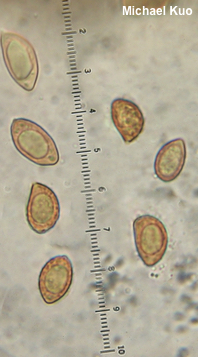| Major Groups > Gilled Mushrooms > Dark-Spored > Cortinarius > Cortinarius seidliae |

|
[Basidiomycota > Agaricales > Cortinariaceae > Cortinarius ... ] Cortinarius seidliae by Michael Kuo, 13 February 2024 The combination of brown and pale lilac doesn't usually come to mind when one imagines beautiful color schemes, but Cortinarius seidliae pulls it off with flair, and winds up being one of the most gorgeous mushrooms on the continent. Look for it under conifers in the Pacific Northwest and northern California. The whole mushroom is covered with a whitish to lilac slime veil when young, resulting in a slimy cap and a slimy lilac stem surface as the mushroom matures. Other distinguishing features include the young gills, which are brownish (not lilac or purple), and microscopic features, including large, flask-shaped spores and the absence of clamp connections. The mushroom featured here was called "Cortinarius vanduzerensis" for many years, but Ammirati and collaborators (in Ariyawansa et al. 2015) determined that the type collection of Cortinarius vanduzerensis was phylogenetically distinct from many collections identified as such. Cortinarius seidliae can be tentatively separated on the basis of its somewhat paler brown cap color and slightly wider spores. Cortinarius brunneoalbus, also recently named from this species group, is another conifer lover from the Pacific Northwest; it has a white, rather than lilac, stem. Description: Ecology: Mycorrhizal with conifers–especially spruces, firs, and Douglas-fir; growing alone, scattered, or gregariously; fall and winter; originally described from Oregon (Smith & Trappe 1972); distributed in the Pacific Northwest and northern California. The illustrated and described collections are from California. Cap: 4–9 cm; obscurely conical, becoming broadly conical or convex, with a central bump; thickly slimy when fresh; smooth when young, often wrinkled with maturity; dark brown, fading to cinnamon brown; appearing lined under the gluten. Gills: Narrowly attached to the stem; close; whitish when in the button stage, becoming pale brown and eventually rusty brown; short-gills frequent. Stem: 8–15 cm long; 1.5–2 cm thick; slightly tapered to apex; often rooting slightly; slimy; whitish to pale lilac above, darker lilac (resulting from the slime veil) below; somewhat shaggy underneath the slime; sometimes with a rusty ring zone. Odor: Not distinctive. Flesh: Whitish or tinged cinnamon. Spore Print: Rusty brown. Microscopic Features: Spores 11–17 x 7–8.5 µm; amygdaliform; very finely verrucose; brown in KOH. Basidia 40–45 x 10–12 µm; clavate; 4-sterigmate. Cystidia not found. Pileipellis an ixocutis of elements 3–5 µm wide, smooth; hyaline in KOH, without clamp connections. REFERENCES: J. F. Ammirati, T. Niskanen & K. Liimatainen, 2015. (Smith & Trappe, 1972; Smith, Smith & Weber, 1979; Arora, 1986; Schalkwijk-Barendsen, 1992; Seidl, 2000; Trudell & Ammirati, 2009; Kuo & Methven, 2010; Ariyawansa et al., 2015; Desjardin, Wood & Stevens, 2015; Siegel & Schwarz, 2016.) Herb. Kuo 01132401. This site contains no information about the edibility or toxicity of mushrooms. |
© MushroomExpert.Com |
|
Cite this page as: Kuo, M. (2024, February). Cortinarius seidliae. Retrieved from the MushroomExpert.Com Web site: http://www.mushroomexpert.com/cortinarius_seidliae.html |
